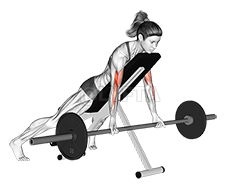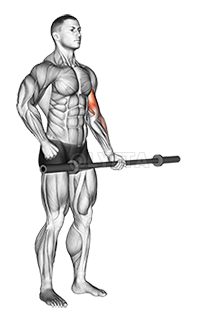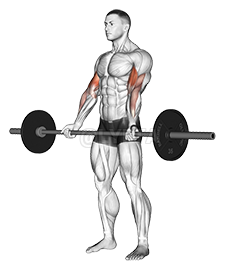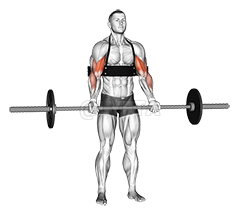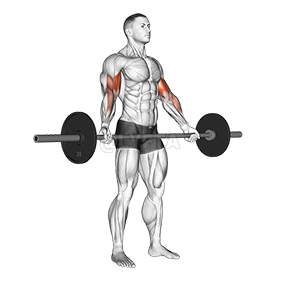
Barbell Drag Curl
Exercise Profile
Related Exercises:
Introduction to the Barbell Drag Curl
The Barbell Drag Curl is a strength training exercise that primarily targets the biceps, promoting muscle growth and endurance. It's suitable for both beginners and advanced fitness enthusiasts as it helps improve upper body strength and enhance arm aesthetics. Individuals may opt for this exercise as it provides a unique tension angle on the biceps, promoting better muscle activation and potentially faster results compared to traditional curls.
Performing the: A Step-by-Step Tutorial Barbell Drag Curl
- Keep your elbows close to your torso at all times and maintain your body stationary, then start to curl the weights while keeping the barbell close to your body.
- Continue to raise the barbell by flexing at the elbow until your biceps are fully contracted and the bar is at shoulder level. Hold the contracted position for a brief pause as you squeeze your biceps.
- Slowly begin to bring the barbell back to the starting position as your breathe in.
- Repeat for the recommended amount of repetitions.
Tips for Performing Barbell Drag Curl
- Proper Grip: Hold the barbell with an underhand grip, with your hands shoulder-width apart. Make sure your grip is firm but not overly tight as it can cause unnecessary strain on your wrists.
- Drag, Don't Lift: The name "drag curl" comes from the motion of dragging the barbell up along your body. Instead of lifting the barbell away from your body like in a traditional curl, keep it close to your body, dragging it up your torso. This will engage your biceps more effectively.
- Controlled Movement: Avoid using momentum to lift the barbell. The movement should be slow and controlled, both while lifting and lowering the
Barbell Drag Curl FAQs
Can beginners do the Barbell Drag Curl?
Yes, beginners can do the Barbell Drag Curl exercise. However, it's important to start with a lighter weight to ensure proper form and prevent injury. Gradually increase the weight as strength and technique improve. It's always a good idea to have a professional trainer or experienced individual demonstrate the exercise first to ensure you are doing it correctly.
What are common variations of the Barbell Drag Curl?
- Incline Drag Curl: This variation is performed on an incline bench, which changes the angle of the movement and targets different parts of the biceps.
- Seated Drag Curl: Instead of standing, this variation is performed while seated, which can help to isolate the biceps by preventing any momentum or swinging.
- Reverse Grip Drag Curl: This variation uses a reverse grip on the barbell, which can help to target the brachialis muscle and the forearms in addition to the biceps.
- EZ Bar Drag Curl: This variation uses an EZ curl bar, which can be more comfortable for some people and can help to target different parts of the biceps.
What are good complementing exercises for the Barbell Drag Curl?
- The Preacher Curl is another related exercise as it isolates the biceps, similar to the Barbell Drag Curl, but with a different grip and range of motion, which helps to target different muscle fibers and improve overall biceps growth.
- The Incline Dumbbell Curl complements the Barbell Drag Curl by working the long head of the biceps more intensely, providing a stretch that the Drag Curl doesn't, and thus promoting a more comprehensive development of the biceps.
Related keywords for Barbell Drag Curl
- Barbell Bicep Exercise
- Drag Curl Workout
- Upper Arm Barbell Training
- Bicep Strengthening with Barbell
- Barbell Drag Curl Techniques
- Intensive Bicep Workout
- Barbell Exercise for Upper Arms
- Building Biceps with Barbell Drag Curl
- Gym Workout Barbell Drag Curl
- Muscle Building with Barbell Drag Curl
